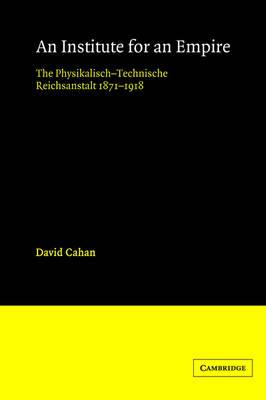
An Institute for an Empire
The Psysikalisch-Technische Reichsanstalt, 1871–1918
Seiten
2004
Cambridge University Press (Verlag)
978-0-521-52519-0 (ISBN)
Cambridge University Press (Verlag)
978-0-521-52519-0 (ISBN)
An Institute for an Empire is the first scholarly study of Imperial Germany's leading scientific institution. The Reichsanstalt demonstrated how physics and industrial technology could help build a modem society and a modem nation-state; it also encouraged and helped inaugurate the era of Big Science.
An Institute for an Empire is the first scholarly study of one of the world's foremost scientific institutions, the Physikalisch-Technische Reichsanstalt (PTR) in Imperial Germany. The Reichsanstalt stood at the forefront of institutional innovation in science and technology during the late nineteenth and early twentieth centuries, uniting diverse practitioners and representatives of physics, technology, industry, and the state. It demonstrated how physics and industrial technology could help build a modem society and a modem nation-state. Moreover, it encouraged and helped inaugurate the era of Big Science. Professor Cahan also discusses the Reichsanstalt's leaders and scientists, including Wemer von Siemens and Hermann von Helmholtz, as well as its scientific and technological work. Among the Reichsanstalt's many accomplishments were contributions to the new quantum physics, development of physical standards and measuring instruments for science, industry, and the state, and testing work for a variety of German industries.
An Institute for an Empire is the first scholarly study of one of the world's foremost scientific institutions, the Physikalisch-Technische Reichsanstalt (PTR) in Imperial Germany. The Reichsanstalt stood at the forefront of institutional innovation in science and technology during the late nineteenth and early twentieth centuries, uniting diverse practitioners and representatives of physics, technology, industry, and the state. It demonstrated how physics and industrial technology could help build a modem society and a modem nation-state. Moreover, it encouraged and helped inaugurate the era of Big Science. Professor Cahan also discusses the Reichsanstalt's leaders and scientists, including Wemer von Siemens and Hermann von Helmholtz, as well as its scientific and technological work. Among the Reichsanstalt's many accomplishments were contributions to the new quantum physics, development of physical standards and measuring instruments for science, industry, and the state, and testing work for a variety of German industries.
List of illustrations; List of tables; Acknowledgments; Abbreviations; German institutions, organizations, and agencies; Introduction; 1. Physics and empire; 2. Rift in the foundations; 3. Between charisma and bureaucracy; 4. Masters of measurement; 5. The search for reform; Notes; Bibliography; Index.
| Erscheint lt. Verlag | 23.12.2004 |
|---|---|
| Zusatzinfo | Worked examples or Exercises |
| Verlagsort | Cambridge |
| Sprache | englisch |
| Maße | 152 x 229 mm |
| Gewicht | 500 g |
| Themenwelt | Geschichte ► Teilgebiete der Geschichte ► Technikgeschichte |
| Naturwissenschaften | |
| ISBN-10 | 0-521-52519-5 / 0521525195 |
| ISBN-13 | 978-0-521-52519-0 / 9780521525190 |
| Zustand | Neuware |
| Haben Sie eine Frage zum Produkt? |
Mehr entdecken
aus dem Bereich
aus dem Bereich
Buch | Softcover (2024)
Lehmanns Media (Verlag)
CHF 27,90
Digitalisierung neu denken für eine gerechte Gesellschaft
Buch | Hardcover (2023)
Quadriga (Verlag)
CHF 27,95
Vom Perceptron zum Deep Learning
Buch | Softcover (2022)
Springer Vieweg (Verlag)
CHF 27,95


